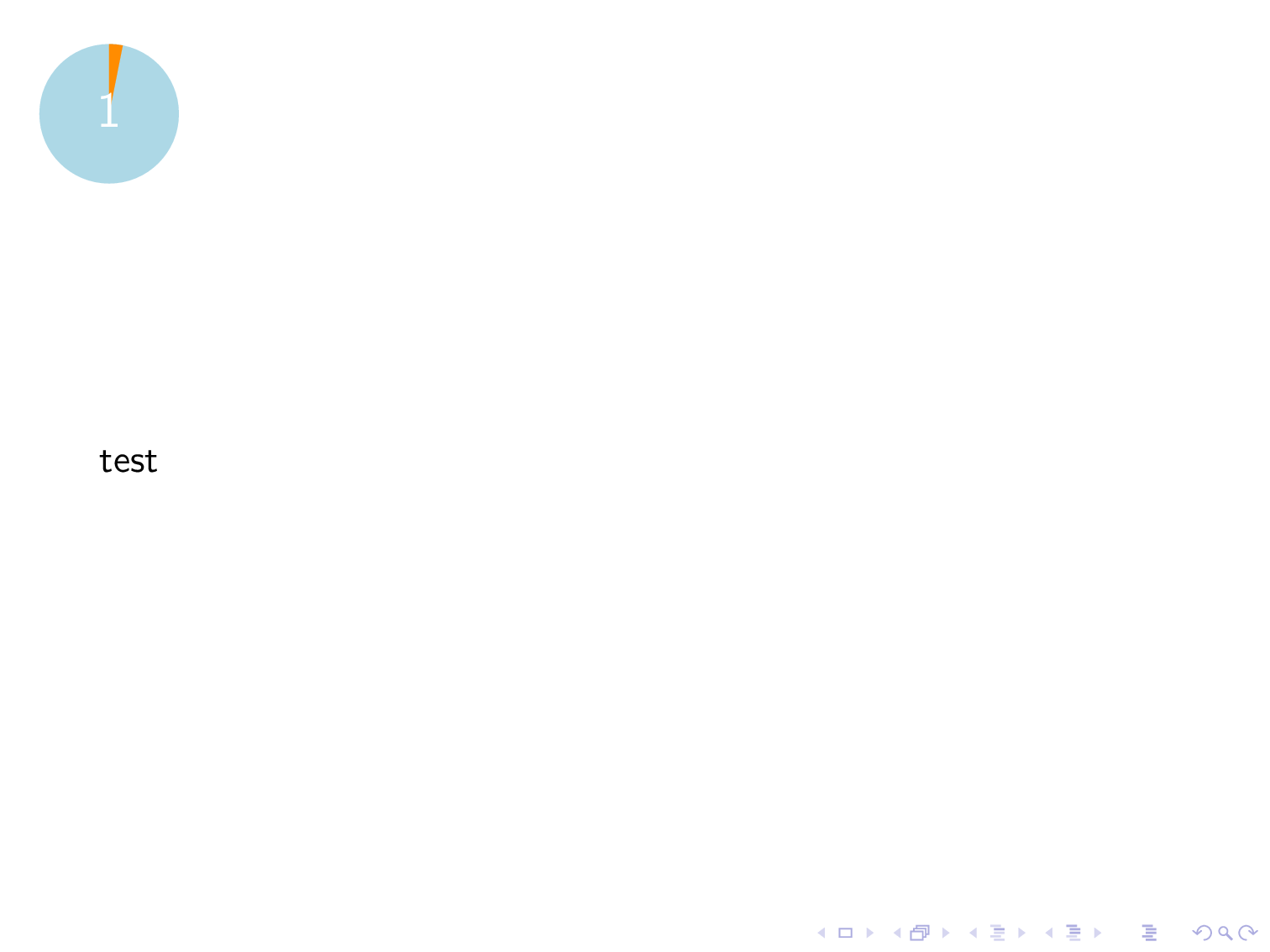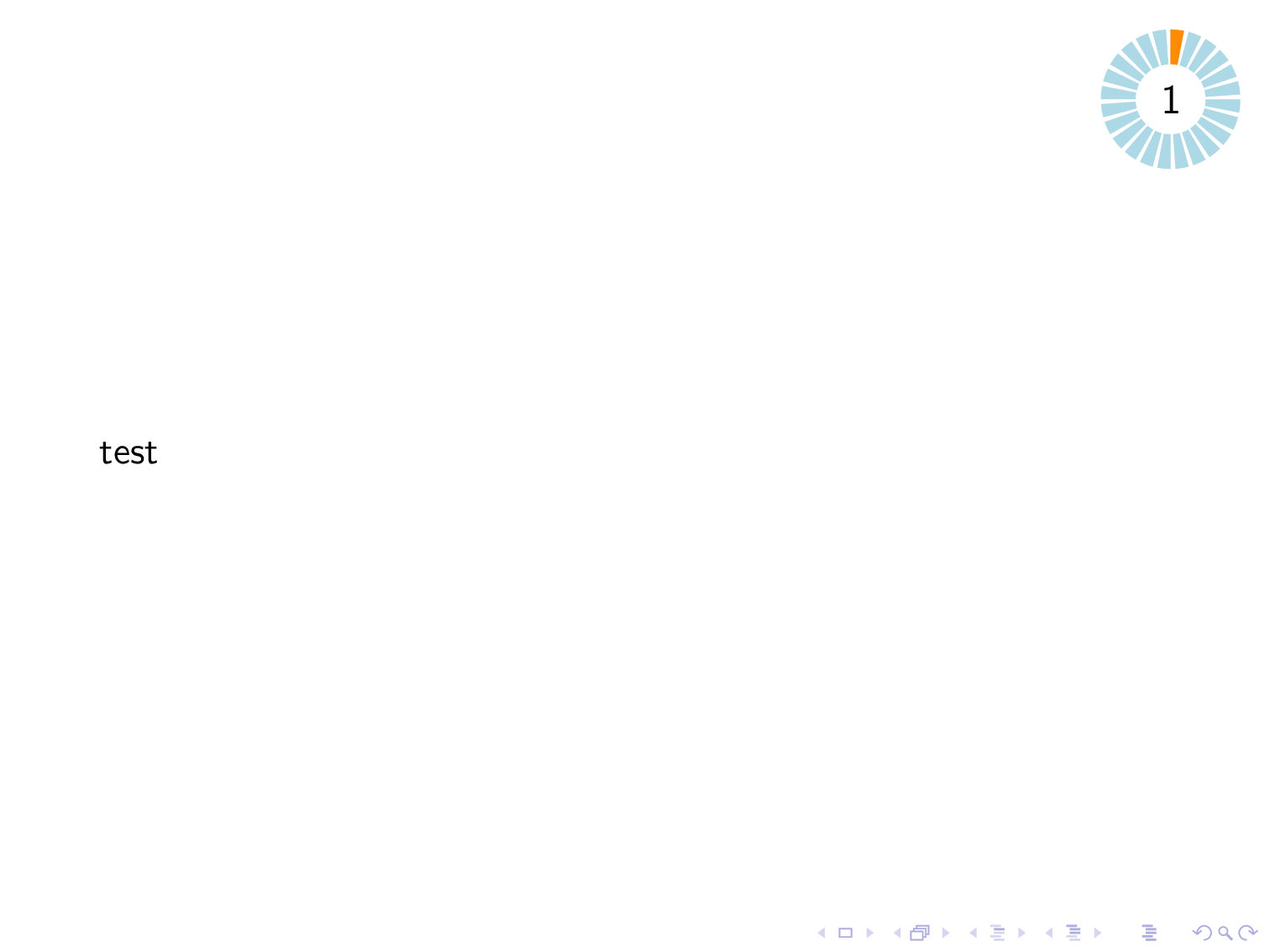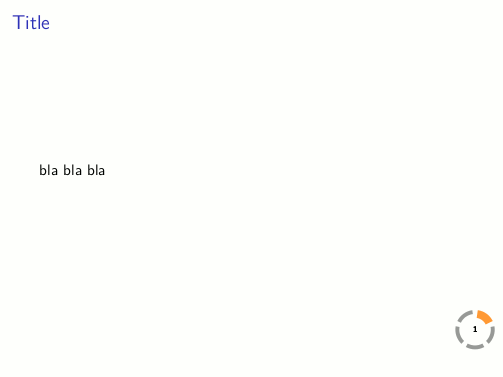Is it possible to customize frame number like figure below?
-
3Yes, it is possible. Have a look at github.com/adityam/visualcounter, there you can find something similar [github.com/adityam/visualcounter/blob/master/visualcounter.pdf page 19]– samcarter_is_at_topanswers.xyzApr 14, 2014 at 12:43
3 Answers
Below I present two options:
\documentclass{beamer}
\usepackage{tikz}
\definecolor{color1}{RGB}{173,216,230}
\definecolor{color2}{RGB}{255,140,0}
\newcounter{totavalue}
\def\aux{1}
\def\radius{20pt}
\newcommand\circcounteri{%
\ifnum\inserttotalframenumber<2\relax
\else
\setcounter{totavalue}{\inserttotalframenumber}%
\fi%
\pgfmathsetmacro{\aux}{360/\thetotavalue}%
\begin{tikzpicture}[overlay]
\fill[color1]
(0,0) -- (0:\radius) arc (0:360:\radius) -- cycle;
\fill[color2]
(0,0) -- (90:\radius) arc (90:90-\insertframenumber*\aux:\radius) -- cycle;
\node[font=\color{white}] at (0,0) {\strut\Large\insertframenumber};
\end{tikzpicture}%
}
\addtobeamertemplate{headline}{}{\vskip1cm\hspace*{15pt}smash\circcounteri\hfill}
\newcommand\TestFr{\begin{frame}
test
\end{frame}}
\begin{document}
\TestFr\TestFr\TestFr\TestFr\TestFr\TestFr\TestFr\TestFr
\TestFr\TestFr\TestFr\TestFr\TestFr\TestFr\TestFr\TestFr
\TestFr\TestFr\TestFr\TestFr\TestFr\TestFr\TestFr\TestFr
\TestFr\TestFr\TestFr\TestFr\TestFr\TestFr\TestFr\TestFr
\end{document}

The second fancier option (this might take longer to process for a presentation with many frames):
\documentclass{beamer}
\usepackage{tikz}
\definecolor{color1}{RGB}{173,216,230}
\definecolor{color2}{RGB}{255,140,0}
\newcounter{totavalue}
\newcounter{parvalue}
\def\aux{1}
\def\radius{20pt}
\def\step{4pt}
\newcommand\circcounter{%
\ifnum\inserttotalframenumber<2\relax
\else
\setcounter{totavalue}{\inserttotalframenumber}
\setcounter{parvalue}{\insertframenumber}
\ifnum\inserttotalframenumber>45\relax
\renewcommand\step{0pt}
\fi%
\pgfmathsetmacro{\aux}{360/\thetotavalue}
\begin{tikzpicture}[remember picture,overlay,rotate=90+\aux]
\foreach \i in {0,1,...,\thetotavalue}
\fill[color1]
(0,0) -- (-\i*\aux:\radius) arc (-\i*\aux:-(\i+1)*\aux+\step:\radius) -- cycle;
\foreach \i in {1,...,\insertframenumber}
\fill[color2]
(0,0) -- (-\i*\aux:\radius) arc (-\i*\aux:-(\i+1)*\aux+\step:\radius) -- cycle;
\fill[white] circle (\radius/2);
\node at (0,0) {\large\insertframenumber};
\end{tikzpicture}%
\fi%
}
\addtobeamertemplate{headline}{}{\vskip1cm\hfill\circcounter\hspace*{1cm}}
\newcommand\TestFr{\begin{frame}
test
\end{frame}}
\begin{document}
\TestFr\TestFr\TestFr\TestFr\TestFr\TestFr\TestFr\TestFr
\TestFr\TestFr\TestFr\TestFr\TestFr\TestFr\TestFr\TestFr
\TestFr\TestFr\TestFr\TestFr\TestFr\TestFr\TestFr\TestFr
\end{document}

-
-
But it doesnt work by lualatex when I use luapersian package and it has some errors like : ! TeX capacity exceeded, sorry [input stack size=5000]. Apr 14, 2014 at 19:52
-
@user49875 I'm sorry to hear that; unfortunately, I don't have the
luapersianpackage, so I cannot do any tests to diagnose the problem. You could consider opening a follow-up question mentioning the problem there and providing a minimal version of the code (a little test document like the one in the answers) that is not working. Apr 14, 2014 at 19:56
Basically, this answer is just a minor revision from my previous one Visual counter for LaTeX? and I will present a few version, all customizable through a user-friendly key-value interface.
From the original solution, a few changes should be performed:
- removed
beameruseless option; - set
radiusandthicknessoptions to the same value to get sectors; - set a negative value to
segment distanceto avoid separation between sectors; - added the page number through
\insertframenumber.
And here it is an example:
\documentclass{beamer}
\usepackage{lmodern}
\usepackage{tikz}
\usetikzlibrary{calc}
\setbeamertemplate{navigation symbols}{}
\pgfkeys{/visual counter/.cd,
thickness/.store in=\thickness,
thickness=0.4ex,
radius/.store in=\radius,
radius=1.5ex,
segment distance/.store in=\segdist,
segment distance=8,
color current frame/.store in=\colcurrframe,
color current frame=orange,
color old frame/.store in=\cololdframe,
color old frame=blue,
color next frame/.store in=\colnextframe,
color next frame=gray!30,
color page number/.store in=\colpagenum,
color page number=white,
current value/.store in=\currentv,
current value=1,
total value/.store in=\totalv,
total value=2,
circled page number/.code={
\begin{tikzpicture}[fill color/.style={}]
\pgfkeys{/visual counter/.cd,
current value=\insertframenumber,
total value=\inserttotalframenumber,
}
\pgfmathtruncatemacro\current{\currentv+1}
\def\tot{\totalv}
\def\radiusout{\radius}
\def\radiusin{\radius-\thickness}
\foreach \s in {1,...,\tot}
{
\ifnum\s>\current%
\tikzset{fill color/.append style={\colnextframe}}%
\fi%
\ifnum\s=\current%
\tikzset{fill color/.append style={\colcurrframe}}%
\fi%
\ifnum\s<\current%
\tikzset{fill color/.append style={\cololdframe}}%
\fi%
\fill[fill color]
({90-360/\tot * (\s - 1)-\segdist}:\radiusout) arc
({90-360/\tot * (\s - 1)-\segdist}:{90-360/\tot * (\s)+\segdist}:\radiusout) --
({90-360/\tot * (\s)+\segdist}:\radiusin) arc
({90-360/\tot * (\s)+\segdist}:{90-360/\tot * (\s - 1)-\segdist}:\radiusin);
% new addition
\node[inner sep=0pt,text=\colpagenum] at (0,0){\insertframenumber};
}
\end{tikzpicture}
},
}
% new footline with
\setbeamertemplate{footline}{
\begin{beamercolorbox}[wd=0.95\textwidth, ht=2ex,dp=1ex,sep=1ex]{footline}
\hfill%
\tikz\node[/visual counter/.cd,
segment distance=-2pt,
radius=0.5cm, thickness=0.5cm,
color old frame=orange!50,
color current frame=cyan!80!gray!50,
color next frame=cyan!80!gray!50,
circled page number,
]{};
\end{beamercolorbox}
}
\begin{document}
\begin{frame}{Title}
bla bla bla
\end{frame}
\begin{frame}{Something else}
bla bla bla
\end{frame}
\begin{frame}{Different title}
bla bla bla
\end{frame}
\begin{frame}{Another one}
bla bla bla
\end{frame}
\begin{frame}{Final}
bla bla bla
\end{frame}
\end{document}
The result:

Just for demonstration, with a simple change of the footline template in the previous document into:
% new footline with
\setbeamertemplate{footline}{
\begin{beamercolorbox}[wd=0.95\textwidth, ht=2ex,dp=1ex,sep=1ex]{footline}
\hfill%
\tikz\node[/visual counter/.cd, beamer=true,
radius=0.5cm, thickness=0.225cm,
color old frame=orange!80,
color current frame=cyan!80!gray!80,
color next frame=cyan!80!gray!80,
color page number=black,
circled page number,
]{};
\end{beamercolorbox}
}
it is possible to achieve the same result of Gonzalo's fancy option:

With:
% new footline with
\setbeamertemplate{footline}{
\begin{beamercolorbox}[wd=0.95\textwidth, ht=2ex,dp=1ex,sep=1ex]{footline}
\hfill%
\tikz\node[/visual counter/.cd, beamer=true,
radius=0.5cm, thickness=0.175cm,
color old frame=cyan!80!gray!80, % <= just set a different coloring
color current frame=orange!80,
color next frame=gray!80,
color page number=black,
circled page number,
]{};
\end{beamercolorbox}
}
the result becomes:

Another possibility is to have different thickness for frames to be appear compared to current frame and frames already appeared; for this, we should just change the thickness value of circled page number key:
circled page number/.code={
\begin{tikzpicture}[fill color/.style={}]
\pgfkeys{/visual counter/.cd,
current value=\insertframenumber-1,
total value=\inserttotalframenumber,
}
\pgfmathtruncatemacro\current{\currentv+1}
\pgfmathtruncatemacro\tot{\totalv}
\def\radiusout{\radius}
\def\radiusin{\radius-\thickness}
\foreach \s in {1,...,\tot}
{
\ifnum\s>\current%
\tikzset{fill color/.append style={\colnextframe}}%
\pgfkeys{/visual counter/thickness={0.1cm}}% <= new addition
\fi%
\ifnum\s=\current%
\tikzset{fill color/.append style={\colcurrframe}}%
\fi%
\ifnum\s<\current%
\tikzset{fill color/.append style={\cololdframe}}%
\fi%
\fill[fill color]
({90-360/\tot * (\s - 1)-\segdist}:\radiusout) arc
({90-360/\tot * (\s - 1)-\segdist}:{90-360/\tot * (\s)+\segdist}:\radiusout) --
({90-360/\tot * (\s)+\segdist}:\radiusin) arc
({90-360/\tot * (\s)+\segdist}:{90-360/\tot * (\s - 1)-\segdist}:\radiusin);
% new addition
\node[inner sep=0pt,text=\colpagenum] at (0,0){\insertframenumber};
}
\end{tikzpicture}
},
(of course introducing another key would be far way better, but it's quite easy). It leads to:

-
It doesnt work by lualatex when I use luapersian package and it has some errors like : ! TeX capacity exceeded, sorry [input stack size=5000]. Apr 14, 2014 at 19:55
-
@user49875 as I said in a comment to my answer, I think the best thing to do here is to ask a follow-up question. Apr 14, 2014 at 19:56
-
@user49875: I agree with Gonzalo, a fresh question would be better. Like him, I don't have
luapersianpackage; however, I can tell you that testing the documents with lualatex, the compilation was fine both times. Apr 15, 2014 at 11:06
To expand on samcarter's comment, this is how such a counter can be displayed using the visualcounter module in ConTeXt. (Full disclosure: I am author of visual counter module).
First, we need to define a Metapost graphic that draws the appropriate shapes. See the documentation for what the predefined parameters mean:
\usemodule[visualcounter]
\unprotect
\definevisualcounter
[clock]
[ \c!mp=visualcounter::clock,
\c!offset=0.5EmWidth,
]
\startuseMPgraphic{visualcounter::clock}
begingroup ;
\includeMPgraphic{visualcounter::initialization}
draw fullcircle scaled 10pt;
if (last_counter > 0) and (current_counter > 0) :
% label
newpicture countertext ; countertext := textext("\visualcounterparameter\c!text");
newpicture max_countertext ; max_countertext := textext("\visualcounterparameter{\c!max\c!text}");
newnumeric diameter;
diameter := max(bbwidth(max_countertext), bbheight(max_countertext))
+ 2*\visualcounterparameter\c!offset;
newpath circle ; circle := reverse (fullcircle scaled diameter) rotated 90;
newnumeric timescale; timescale := arclength (circle)/last_counter ;
newpair current; current := point (current_counter*timescale) on circle;
newpath slice; slice := origin -- (circle cutafter current) -- cycle ;
fill circle withcolor future_color;
fill slice withcolor past_color;
label (countertext, origin) withcolor \visualcounterparameter\c!color ;
fi;
endgroup ;
\stopuseMPgraphic
\protect
Then, it is straightforward to tie this to any ConTeXt counter. For example:
\definecounter[test]
\definevisualcounter
[test]
[clock]
[
style=bold,
color=white,
counter=test,
]
\starttext
\dontleavehmode
\dorecurse{10}{\incrementcounter[test]\usevisualcounter{test}\quad}
\stoptext
which gives:

The label is drawn according to the number conversion specified by the counter. So, if you change:
\definecounter[test][numberconversion=Characters]
you will get

To use this with pagenumbers, use:
\definevisualcounter
[page] % use any identifier
[clock]
[....
counter=userpage,
....]
and then use
\usevisualcounter{page}
wherever you want the page number.
-
-
That is complete ConTeXt code. See tex.stackexchange.com/q/4987/323 and contextgarden.net– AdityaApr 16, 2014 at 18:27
